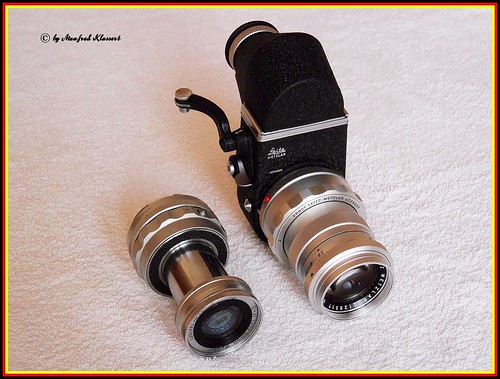Visoflex

|
| Leitz Visoflex II with 90mm Elmarit (right), compared to collapsible Elmar 90mm in standard M mount image by aldabra42 (Image rights) |
The Visoflex is a reflex housing made by Leitz in the 1950s and 60s, to add ground-glass focusing to rangefinder cameras. It is an update of the 1930s PLOOT reflex housing. The reflex housings add greatly to the distance between the lens mount and the film plane: a special range of lenses was made for use with the housings, with short lens-tubes. Because of the length of the reflex housing, these are mostly long-focus lenses.
The Visoflex I was introduced in 1951, originally for screw-mount Leica cameras, but it was also made for the new bayonet-mount M-series cameras after the Leica M3 was introduced in 1954. It requires a double cable release; one cable to release the shutter and a second to activate the mirror-moving mechanism.
The Visoflex II followed in 1960; this was also made for both screw- and bayonet-mount cameras. It has a rigid arm which passes the action of the cable release, attached to the housing, to the shutter release on the camera body.
The Visoflex III was introduced in 1964, and was only made for M-series cameras. This model has an instant-return mirror.
Links
- Auction lot of Visoflex housings and accessories including Visoflex I for both screw and bayonet mount, sold at the thirteenth Westlicht Photographica Auction, on 7 June 2008.
- Visoflex II for screw-mount camera, also sold at the June 2008 Westlicht auction.